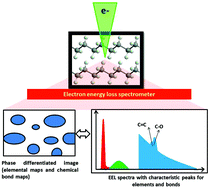Polym. Chem., 2017, 8,6927-6937
DOI: 10.1039/C7PY01459G, Review Article
DOI: 10.1039/C7PY01459G, Review Article
Ruchi Pal, Arun K. Sikder, Kei Saito, Alison M. Funston, Jayesh R. Bellare
Electron energy loss spectroscopy (EELS) allows imaging as well as extraction of spatially resolved chemical information and this review presents how EELS can be ap plied to polymeric systems.
The content of this RSS Feed (c) The Royal Society of Chemistry
Electron energy loss spectroscopy (EELS) allows imaging as well as extraction of spatially resolved chemical information and this review presents how EELS can be ap plied to polymeric systems.
The content of this RSS Feed (c) The Royal Society of Chemistry











